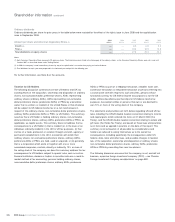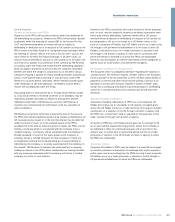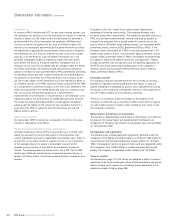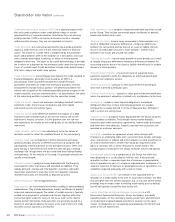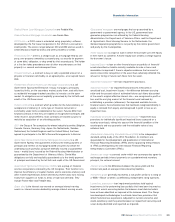RBS 2009 Annual Report Download - page 386
Download and view the complete annual report
Please find page 386 of the 2009 RBS annual report below. You can navigate through the pages in the report by either clicking on the pages listed below, or by using the keyword search tool below to find specific information within the annual report.Shareholder information continued
RBS Group Annual Report and Accounts 2009384
Credit derivative product company (CDPC) is a special purpose entity
that sells credit protection under credit default swaps or certain
approved forms of insurance policies. Sometimes they can also buy
credit protection. CDPCs are similar to monoline insurers. However,
unlike monoline insurers, they are not regulated as insurers.
Credit derivatives are contractual agreements that provide protection
against a credit event on one or more reference entities or financial
assets. The nature of a credit event is established by the protection
buyer and protection seller at the inception of a transaction, and such
events include bankruptcy, insolvency or failure to meet payment
obligations when due. The buyer of the credit derivative pays a periodic
fee in return for a payment by the protection seller upon the occurrence,
if any, of a credit event. Credit derivatives include credit default swaps,
total return swaps and credit swap options.
Credit enhancements are techniques that improve the credit standing of
financial obligations; generally those issued by an SPE in a
securitisation. External credit enhancements include financial
guarantees and letters of credit from third-party providers. Internal
enhancements include excess spread – the difference between the
interest rate received on the underlying portfolio and the coupon on the
issued securities; and over-collateralisation – on securitisation, the value
of the underlying portfolio is greater than the securities issued.
Credit risk assets – loans and advances (including overdraft facilities),
instalment credit, finance lease receivables and other traded
instruments across all customer types.
Credit risk spread is the difference between the coupon on a debt
instrument and the benchmark or the risk-free interest rate for the
instrument’s maturity structure. It is the premium over the risk-free
rate required by the market for the credit quality of an individual debt
instrument.
Credit valuation adjustments are adjustments to the fair values of
derivative assets to reflect the creditworthiness of the counterparty.
Currency swap – an arrangement in which two parties exchange
specific principal amounts of different currencies at inception and
subsequently interest payments on the principal amounts. Often, one
party will pay a fixed interest rate, while the other will pay a floating
exchange rate (though there are also fixed-fixed and floating-floating
arrangements). At the maturity of the swap, the principal amounts are
usually re-exchanged.
Customer accounts comprise money deposited with the Group by
counterparties other than banks and classified as liabilities. They
include demand, savings and time deposits; securities sold under
repurchase agreements; and other short term deposits. Deposits
received from banks are classified as deposits by banks.
Debt restructuring – see renegotiated loans.
Debt securities are transferable instruments creating or acknowledging
indebtedness. They include debentures, bonds, certificates of deposit,
notes and commercial paper. The holder of a debt security is typically
entitled to the payment of principal and interest, together with other
contractual rights under the terms of the issue, such as the right to
receive certain information. Debt securities are generally issued for a
fixed term and redeemable by the issuer at the end of that term. Debt
securities can be secured or unsecured.
Debt securities in issue comprise unsubordinated debt securities issued
by the Group. They include commercial paper, certificates of deposit,
bonds and medium-term notes.
Deferred tax asset – income taxes recoverable in future periods as a
result of deductible temporary differences – temporary differences
between the accounting and tax base of an asset or liability that will
result in tax deductible amounts in future periods – and the carry-
forward of tax losses and unused tax credits.
Deferred tax liability – income taxes payable in future periods as a result
of taxable temporary differences (temporary differences between the
accounting and tax base of an asset or liability that will result in taxable
amounts in future periods).
Defined benefit obligation – the present value of expected future
payments required to settle the obligations of a defined benefit plan
resulting from employee service.
Defined benefit plan – pension or other post-retirement benefit plan
other than a defined contribution plan.
Defined contribution plan – pension or other post-retirement benefit plan
where the employer’s obligation is limited to its contributions to the fund.
Delinquency - a debt or other financial obligation is considered
delinquent when one or more contractual payments are overdue.
Delinquency is usually defined in terms of days past due. Delinquent
and in arrears are synonymous.
Deposits by banks comprise money deposited with the Group by banks
and recorded as liabilities. They include money-market deposits,
securities sold under repurchase agreements, federal funds purchased
and other short term deposits. Deposits received from customers are
recorded as customer accounts.
Derivative – a contract or agreement whose value changes with
changes in an underlying index such as interest rates, foreign exchange
rates, share prices or indices and which requires no initial investment or
an initial investment that is smaller than would be required for other
types of contracts with a similar response to market factors. The
principal types of derivatives are: swaps, forwards, futures and options.
Discontinued operation is a component of the Group that either has
been disposed of or is classified as held for sale. A discontinued
operation is either: a separate major line of business or geographical
area of operations or part of a single co-ordinated plan to dispose of a
separate major line of business or geographical area of operations; or a
subsidiary acquired exclusively with a view to resale.
Exposure at default (EAD) – an estimate of the expected level of
utilisation of a credit facility at the time of a borrower’s default. The EAD
may be higher than the current utilisation (e.g. in the case where further
drawings may be made under a revolving credit facility prior to default)
but will not typically exceed the total facility limit.
Fannie Mae (Federal National Mortgage Association) is a US
Government Sponsored Enterprise. It buys mortgages, principally
issued by banks, on the secondary market, pools them, and sells them
as residential mortgage-backed securities to investors on the open
market. Its obligations are not explicitly guaranteed by the full faith and
credit of the US Government.






